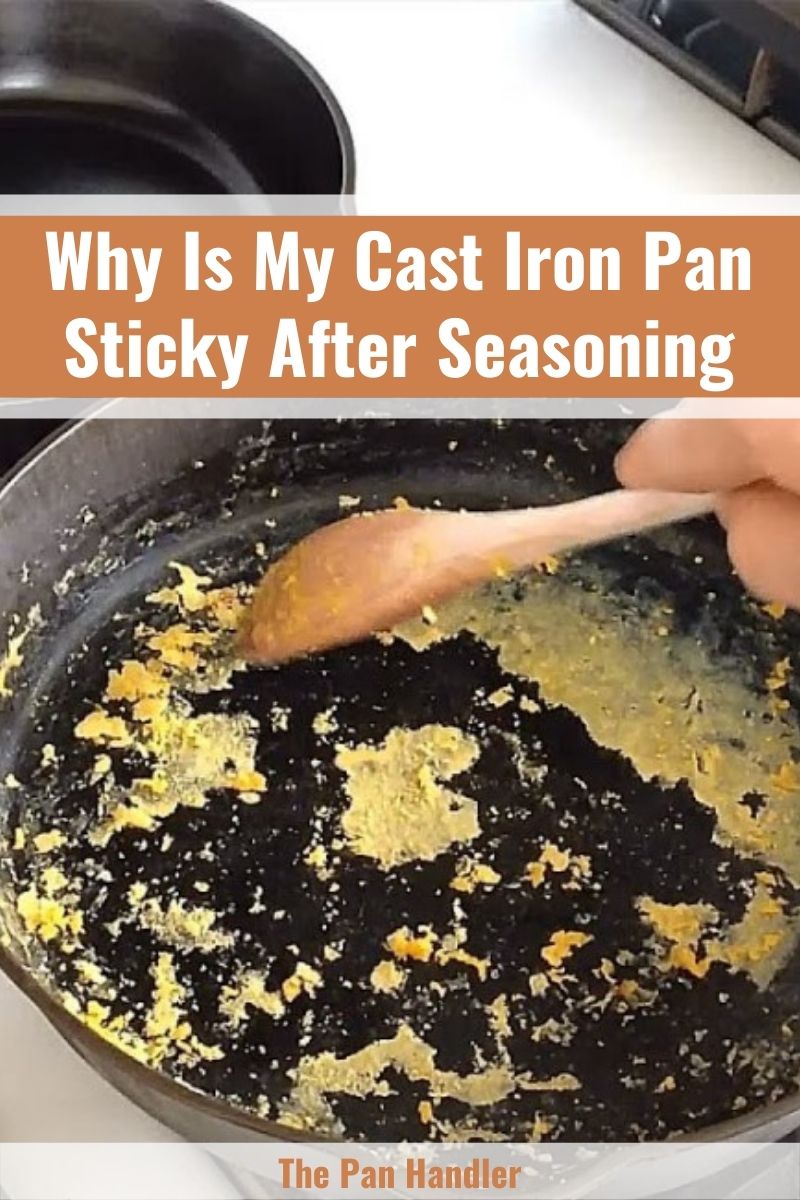It is our nature to take care of the people and things we value. It is like how a musician takes care of his musical instruments, and the same goes for people who love to cook – they take care of their cookware.
Most of us know that a cast-iron pan needs to be seasoned regularly to maintain its non-stick properties. However, despite doing so, you may encounter some problems and ask yourself, “Why is my cast iron pan sticky after seasoning?” Do not worry because we have got you covered!
What is a cast-iron pan?
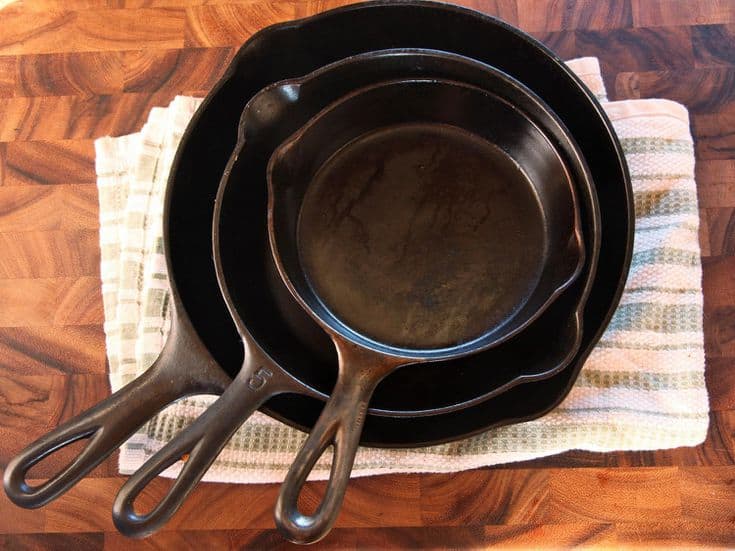
A cast-iron pan is one among many types of cookware. As the name implies, it is made out of cast iron which is considered a great material used for cooking some food.
However, a cast-iron pan is quite heavy. It is a great heat conductor as it absorbs it very well, slowly but surely, allowing it to maintain and distribute the heat in the entire pan evenly. Since it slowly absorbs the heat, it is best used for slow-cooking dishes.
There are two types of cast iron pan, the coated and the uncoated cast iron pan. Take a look at the summary table below to know the difference between the coated and uncoated cast iron pan:
| COATED CAST IRON PAN | UNCOATED CAST IRON PAN | ||
| Pros | Cons | Pros | Cons |
| Enamel coated, hence, does not require to be seasoned | Expensive | Naturally has non-stick property | Needs to be seasoned regularly |
| Non-reactive to acidic and alkaline food | Fragile | Affordable | Reactive to acidic and alkaline food |
| Aesthetic as it comes in various colors | Not feasible for pre-heating | Highly durable and versatile | Naturally heavy and the handles can be extremely hot |
What is seasoning?
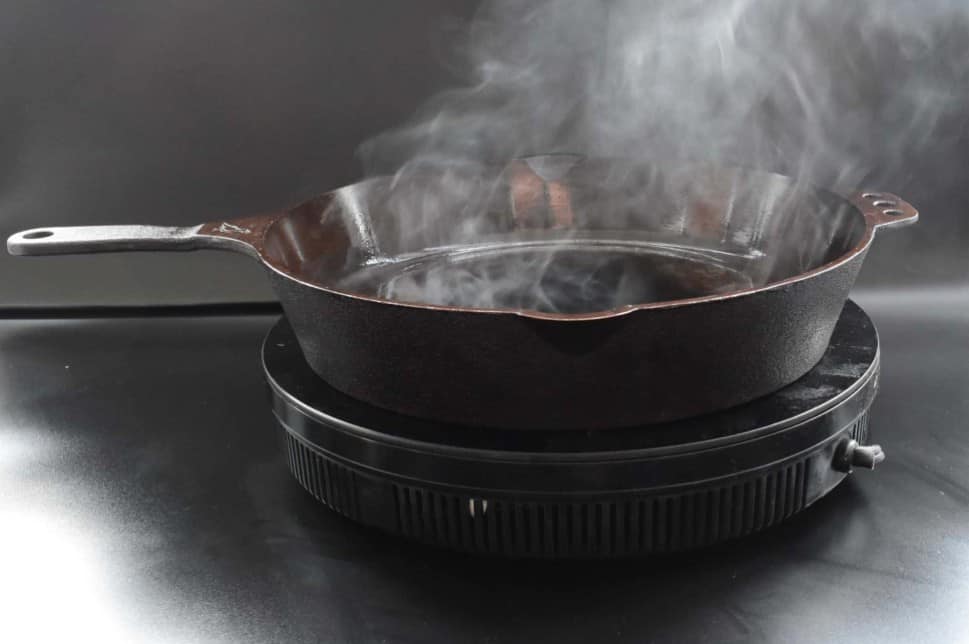
In the context of kitchen cookware, ‘seasoning’ refers to a different concept than the seasoning ingredients used in cooking. It is not about the spices put in our dishes to add flavor, but rather the process of treating the cookware with oil to create a non-stick surface.
Seasoning is required, primarily when using a cast iron pan for cooking. It is a process where you season or add several layers of oil or fat on the entire surface of the cast iron pan. The fat and cooking oil need to be heated to stick onto the metal surface. This is done to protect and provide a non-stick property to the cast iron pan.
When seasoning is done regularly, it maintains the build-up of the non-stick coating, preserving its non-stick property.
5 Reasons why your cast iron pan is sticky even after seasoning
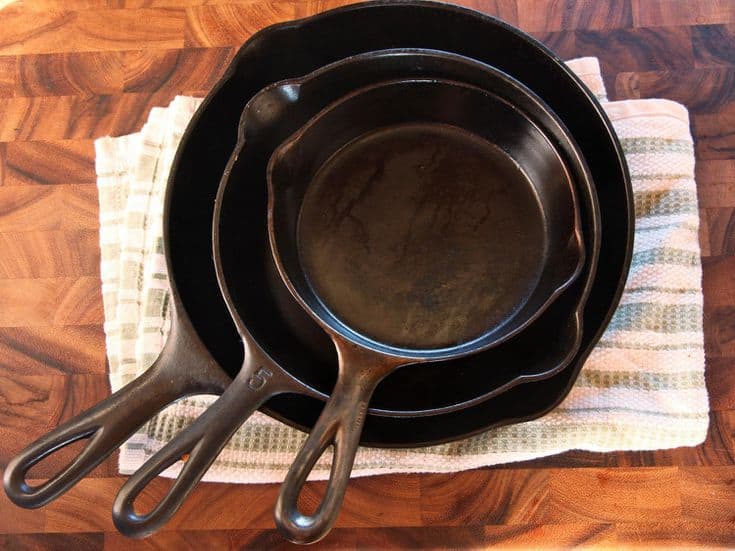
It is common knowledge for professional chefs and people who love to cook that cast iron pans demand constant seasoning. This is a must process to maintain the coating that gives its non-stick properties.
However, you may encounter that your pan is still sticky even after the seasoning process. There are various reasons why this happens, and you can prevent it from being sticky as long as you avoid these common mistakes.
Not enough oil or fat
There are times that your cast iron will still be sticky even if it is adequately seasoned. This mostly happens if you do not use enough fat and oil while you cook.
However, this can be easily fixed. Simply add at least a teaspoon of your preferred cooking oil and spread it across the pan’s surface as it heats up. Now, the coating will make the pan non-stick. Just let it cool down for a little while to let it bond on the metal surface.
Using either too much oil or the wrong choice of cooking oil
This can be a little tricky. You either use too much oil that is never good in the first place or has had the wrong choice of cooking oil.
However, remember to use just the right amount of cooking oil. Using too much can cause a buildup, making the pan surface sticky. If you accidentally put a massive amount of oil on the cooking pan, you can fix this by trying to put your pan upside down in an oven to let the excess oil drip.
On the other hand, when you use the wrong type of oil, it can prevent you from getting a non-stick pan. Ensure that you use cooking oil perfect for a cast iron pan. There are many options for cooking oil with a high smoke point that you should use to season the cast iron pan.
Overcooked Food Residue
Sometimes, when cleaning our kitchen cookware, we might overlook residues. Overcooked and burned food particles can adhere to the pan.
Even if we wash the dishes, we sometimes do not notice the small residues, which can cause your pan to be sticky even after adequately seasoned.
This can be treated by not allowing your food to sit on the pan for quite too long and keeping on stirring the food instead while you cook.
If you cannot avoid this, make sure that you properly clean the cast iron pan, remove the stubborn burnt food, and re-season it again.
Learn how to properly clean a cast iron pan after you use it through the video below
Pan temperature: either too cold or too hot
The trick to cooking a cast iron pan is to reach the right heat temperature. It should never be too cold or too hot.
Ensure that when you cook, your pan should not be cold enough when you put additional oil to boil because it will cause uneven distribution, leading to sticking issues. To fix this, make sure that you preheat your cooktop or oven so your pan will become sufficiently hot as you place it, and then be ready to fill with cooking oil.
On the other hand, your cast iron pan can also be sticky because it is extremely hot. A great sign that your pan is boiling is when you notice a cloud of smoke coming from the surface of the pan. Avoid excessively hot cast iron pan to prevent overcooking food, which can eventually leave residues, leaving your pan sticky.
Frequent seasoning on a stovetop instead of an oven
Although it is possible to season your cast iron pan on a stovetop, sometimes, people tend to forget that this can also cause the stickiness of your cast iron pan. It is always recommended to use an oven instead of seasoning a cast iron pan. Simply because you let the oil cook on the pan evenly compared to a stovetop where it heats the bottom surface first before heating the sidings.
How to properly season a cast-iron pan?
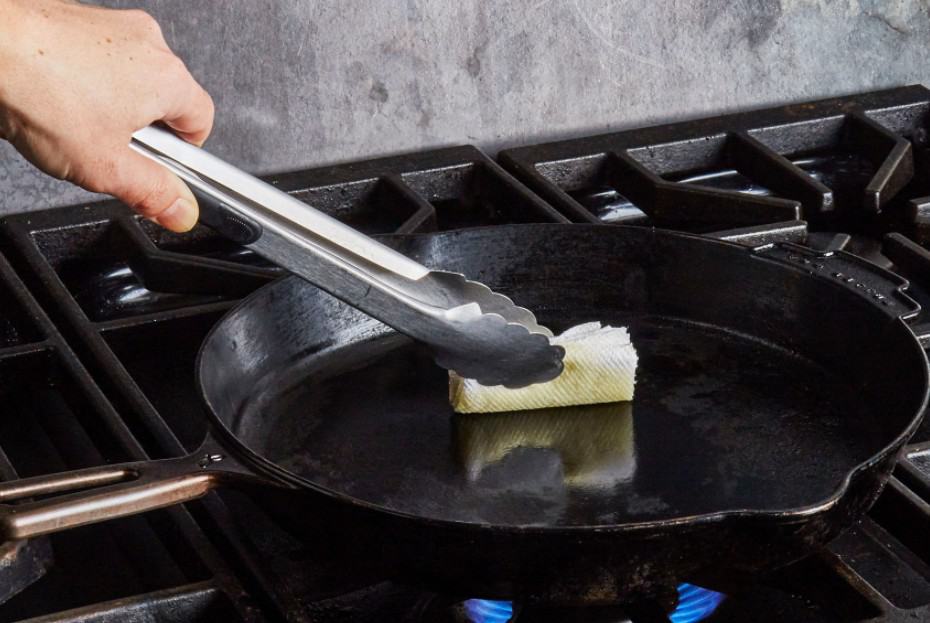
In order to keep your cast iron pan long-lasting, it is necessary that you know how to care for it properly. Hence, seasoning is essential to maintain the non-stick property and prevent significant concerns such as rustiness, stickiness, and a lot more.
The steps are easy, so you will not have a difficult time learning how to season your cast iron pan properly:
- First, wash your cast iron pan thoroughly with warm water and soap. Instead of letting it air dry, use a paper towel or rag to wipe off the water.
- Make sure that you use the correct oil applicable for cast iron pans and rub it onto the whole surface of the pan. Ensure that you have adequately covered the entire cooking surface.
- Ensure that the oven is preheated with at least 450 degrees Fahrenheit before you place the oiled and seasoned cast iron pan and leave it to bake for 30 minutes.
- Repeat the entire process thrice to achieve a well and properly seasoned cast iron pan.
Watch the tutorial on how to season and restore your cast iron pan by clicking the link below
4 Common cast iron pan issues and how to fix them
It is normal and expected that you might encounter some issues with your cast iron pan but make sure that you are familiar with how to deal with it.
Take a look at the table below to know the common cast iron pan issues and learn how to fix them so you can apply them the next time you encounter these concerns.
| CONCERN | CAUSE | SOLUTION |
|
Rustiness |
● Exposure to moisture for quite a long time
● Used a dishwasher or left to soak ● Air-dried instead of using a paper towel or rag to manually dry |
1. Properly clean the cast iron pan by removing the rust through scrubbing.
2. Season cast iron pan by applying a thin layer of cooking oil 3. Bake it evenly by placing the cookware upside down in the oven to let the excess oil drip |
|
Stickiness |
● Inadequate amount of cooking oil or fat
● Excess oil build-up ● Not properly seasoned cookware
|
1. Remove the stubborn burned food residue
2. Add at least a teaspoonful of cooking oil and gradually heat to season the pan evenly |
|
Flaking |
● Improper seasoning will lead to flaking or breaking down
|
1. Scrub the pan to remove any loose black specks or flakes
2. Season the pan and let it bake for at least an hour with 450 to 500 degrees Fahrenheit 3. |
|
Foul Odor |
● Not thoroughly cleaned cookware
|
1. Bake cast iron pan for 15 minutes at 400 degrees Fahrenheit
2. Or sprinkle an ample amount of salt on the cooking surface of the pan and leave it overnight 3. Or thoroughly clean the pan and re-season |
Summary
You will no longer panic when you encounter such concerns when it comes to your ever-precious cookware. Now that you know the reasons and the answer to your question, “Why is my cast iron pan sticky after seasoning?” do not be too complacent with your after-care routine and maintain the newness and prolong the life of your cookware.
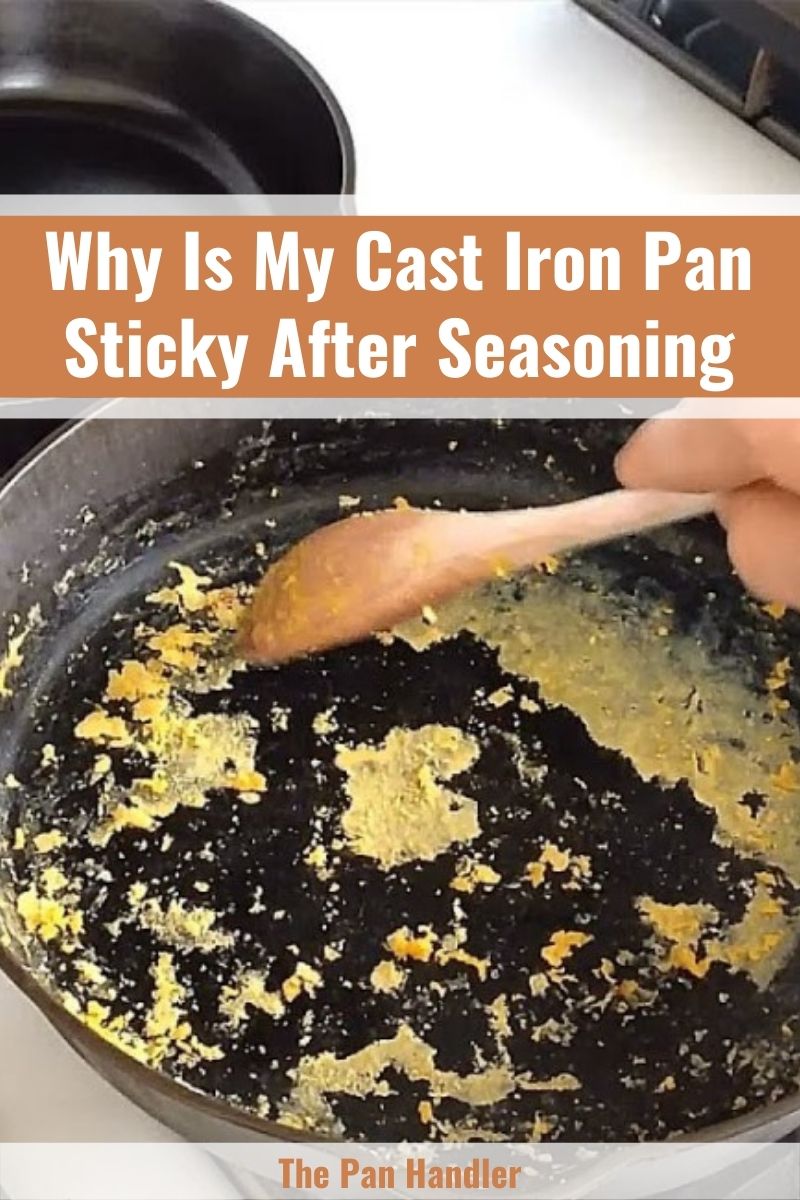

Michael Johnson is the founder of Pan Mastery, Inspired by his blacksmith grandfather’s legacy has a deep appreciation for hand-crafted pots and pans, he provides invaluable guides, reviews, and recipes to enhance your culinary journey.

